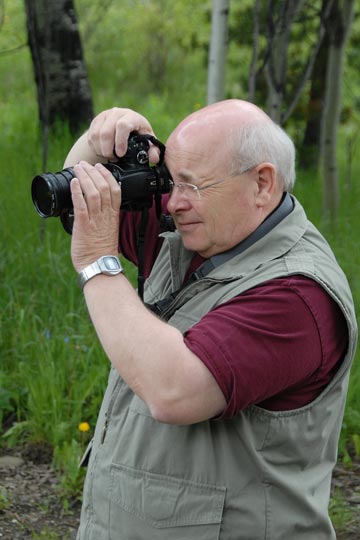Photographer/priest sees the sacred in the everyday
COFFEE WITH WARREN, with Warren Harbeck
Cochrane Eagle, July 25, 2007

Father Fred Monk, in his photo frocks, sees the sacred wherever he points his camera. Photo by Warren Harbeck
Fred Monk, for the past nine years pastor of St. Mary’s Catholic Church, Cochrane, will be assuming new pastoral responsibilities in Bow Island and Foremost, Alta., as of Aug. 1. Many will associate his tenure here with the construction of the parish’s new facilities south of the river. Others will point to the congregational growth on his watch, or to his gifts of liturgy and counselling, and to his initiating humanitarian outreach programs in Mexico.
For my part, I will miss him as a friend and fellow photographer who has taught me much about embracing the sacred in the everyday images of life.
The church’s farewell gathering for him Sunday afternoon featured an exhibition of his photo art, “Images by Fred Monk.”
The 41 works included photographs of a grizzly and her cubs, a spectacular full-sky sunrise, a cattle drive up Grand Valley Road, hoarfrost sparkling diamond-like atop Cochrane Hill, cumulus clouds over a weathered barn, 21 skittering sandpipers mirrored in the wave-washed sand of the Oregon coast, the doorway into a retreat centre’s chapel, and the amazing statue of St. Francis on a lawn at Assisi, Italy.
Only the last two images might in some stereotypical sense be thought of as sacred – or “religious.” But in Father Fred’s eyes, all of them are sacred.
They are sacred, not because they speak of “churchiness” and organized religion, but because they are infused with the divine essence of life itself. The prints resound with an “amen” to the ancient words: “The earth is the Lord’s and all that is in it, the world, and those who live in it” (Psalm 24:1).
This is not to deny the importance of traditional religious symbols, of course. In his use of PowerPoint at weekend Masses, Father Fred is likely to project his images of mirror-shiny communion chalices and stained-glass windows.
But he is just as likely to nestle the words of hymns among fields of daisies or back-lit leaves, or set above a water-colour-like mountainscape looking west from the Toki area south of Cochrane, a photo he took while we were on a rural trek just a few weeks ago.
There are some, of course, who question the place of such natural images in the church. A few even wonder whether his images are “too secular.”
But I would come to the defense of my photo-frocked friend, not only on the basis of the above psalm, but on the basis of Jesus’ own words.
Jesus might not have used a dSLR (digital single-lens reflex) camera and PowerPoint for his images, but he certainly used parables. And what he saw through the lenses of his eyes he made the subjects of sacred story.
There were those verbal snapshots of lilies of the field, a city on a hillside, birds unburdened by the baggage of life, and a house built on sand and another on rock. There were those scenes of a sower sowing seed on various kinds of ground, a field ready for harvest, the threatening waves of a stormy sea, a small mustard seed that grew into a great shrub, and a stranger becoming a neighbour to another along life’s troubled path.
Jesus saw the sacred in the everyday images of life, and camera in hand, so does photographer/priest Fred Monk.
And this is his parting legacy to me: the joy of seeing and celebrating the sacred wherever and whenever possible, whether in a field, a flower, an eagle against a billowing cloud, or a baby’s beaming face.
Thank you, my friend.
© 2007 Warren Harbeck
JoinMe@coffeewithwarren.com